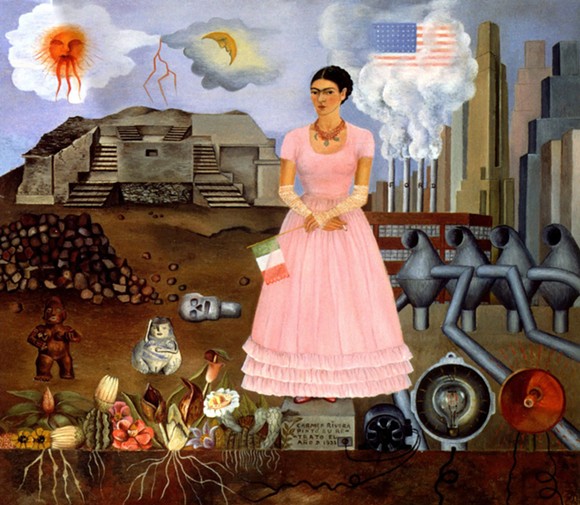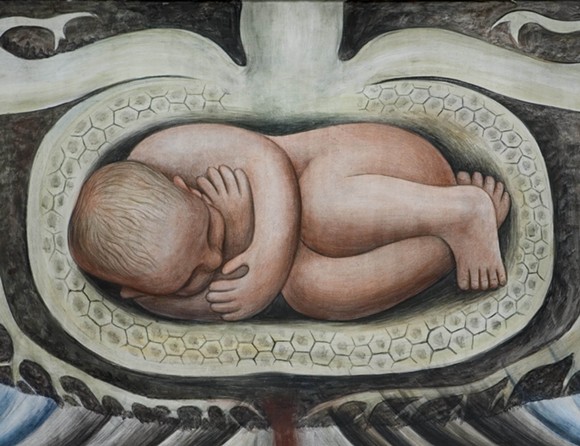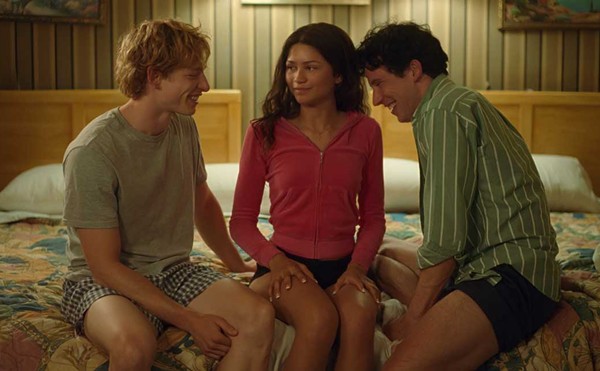The DIA hosted a media preview for its big Diego Rivera and Frida Kahlo in Detroit Tuesday morning, with Rivera's grandson Juan Coronel Rivera on hand to offer his own remarks on the exhibition. At its time, he said, his grandfather's "Detroit Industry" murals created for the DIA were the most important work of modern art in the United States.
Rarely seen full-size drawings of the murals are on display, offering a peek behind Rivera's process. The exhibition also includes other paintings and drawings the two artists created before, during, and after their year in Detroit — in addition to photographs and films.
Highlights include a detailed account of the facts that led up to Kahlo's miscarriage (or was it an abortion?), an event that was pivotal to both artists. While Kahlo's surreal depictions of the event (with Detroit in the background) are well-known, the exhibition shows that after the incident, Rivera changed a large panel in his murals originally depicting an agricultural scene to the more iconic fetal infant in a plant bulb.
In short, the exhibition made us appreciate our favorite work of art at the DIA even more. And in a smart move meant to be inclusive with the Latino community in metro Detroit (and beyond), the exhibit is in both English and Spanish. It opens to the public from March 15 through July 12 — check out the DIA's website for more information.
Other things we learned:
- Diego Rivera’s full name is Diego María de la Concepción Juan Nepomuceno Estanislao de la Rivera y Barrientos Acosta y Rodríguez. Frida Kahlo’s given name was Magdalena Carmen Frieda Kahlo y Calderón.
- The original deal was for Rivera to paint the two main walls in the museum court for a fee of $10,000 — well below his usual rate of $100 per square yard. Edsel Ford was so into Rivera’s preliminary drawings that he increased Rivera’s commission to $20,889. A few days later Rivera presented a plan to paint all four walls — with no increase in his fee. He wound up being paid only $27.52 per square yard. ¡Gangas!
- Rivera created 13 preparatory drawings in 1932 for the Detroit Industry murals and gave them to the museum upon completion of the work. The drawings were not looked at for more than 30 years, and had not been digitally photographed until 2014. Due to their fragility, the drawings are not loaned to other museums and were last on view in the 1986 exhibit Diego Rivera: A Retrospective.
- Twenty-seven panels make up the "Detroit Industry" murals — the largest panels are 17-feet-high and 75-feet-long.
- The longest recorded working session was nearly 24 hours, from August 20 at 11 a.m. to August 21 at 8 a.m.
- Some speculate that the child in the "Vaccination" panel of the "Detroit Industry" murals was modeled after the kidnapped baby of Charles Lindbergh — at the time, the kidnapping was the biggest story in the news.
- While Rivera and Kahlo were in Detroit, they stayed at the Wardell Apartment Hotel, now known as the Park Shelton. After Rivera demanded that the hotel change their policy to not allow Jewish people in the hotel, the management changed its policy.
- In April 2014, Rivera’s "Detroit Industry" murals were named a National Historic Landmark — a total surprise to the DIA.








